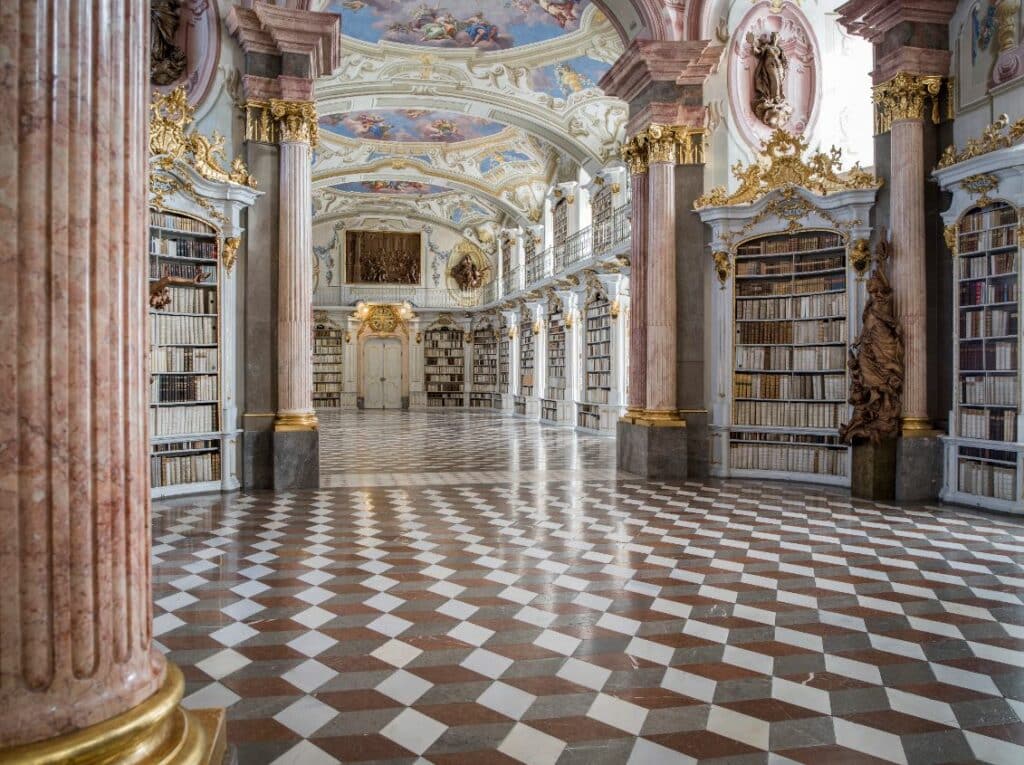
Library collections
Sie sind hier: Home > Abbey Archive > Library collections
This saying is entirely justified: for books have always been the spiritual ‘armour’ of religious. They were required for liturgy and spiritual reading as well as for scientific matters, for teaching and administration.
ONLINE LIBRARY COLLECTIONS
Incunable Online catalogue for printed works Medieval manuscripts Digitalised catalogue for printed works from about 1980
The history of the Abbey Library begins with the foundation of the monastery in 1074. It is pretty certain that the small group of monks from Salzburg, who took up monastic life in Admont in the autumn of 1074, brought a basic stock of books from their mother monastery St Peter. In addition, early book donations were made by the founder of the monastery, Archbishop Gebhard of Salzburg.
First of all, the huge three-volume bible from around 1070, which the founder of the monastery himself handed over to his favourite foundation, Admont, should be mentioned here. From the same period, we have a gospel with splendidly decorated book paintings. From the middle of the 12th century, Admont Abbey had its own writing room (scriptorium), in which numerous books were produced for the Abbey's own needs as well as for other monasteries.
In the period around 1300, Abbot Engelbert, arguably the most versatile scholar in the history of the Abbey, increased the volume of books with a large number of his own works. After the invention of printing, the number of written works increased sharply. By the end of the 16th century, more than 3,000 books produced by printing presses came from Admont.

From the diversity of a medieval collection of books
Those precious Bible manuscripts which the founder of the monastery handed over to the monks in 1074 are at the core of Admont Abbey Library. ‘The Bible’ is a collection of more than 70 books from a period stretching more than thousand years. St Benedict described the Bible in his Rule as the ‘Bibliotheca’ per se. Around the monastery library's core, a stately collection of codices soon grew. These were partly written in the Abbey's own scriptorium, partly also acquired as gifts, exchanges and purchases.
As early as the ‘Admont Reform’ in the 12th century, clear outlines of a ‘universal library’ can be seen: In addition to a large number of theological and historiographical works, there were already some important writings by authors of the ‘pagan’ antiquity, as well as literature on natural history and major works on jurisprudence.
Subsequently, this collection was significantly expanded in all the aforementioned areas and supplemented by reference works, philosophical writings and, above all, medical books, so that the library soon covered both the spectrum of the ‘free arts’ and the classical faculties. A considerable part of that knowledge was thus available in Admont's well-stocked book collection, which you could otherwise only access in the urban educational centres.
The medieval library already pre-empts the thematic structure of extraordinary modern book collections in the large library hall. The 18th century library is divided into three sections. There, the extensive stock of printed volumes is divided into thirteen sections. Compared to the number of medieval codices, it is almost a hundred times larger. The showcases of the likewise three-room ‘manuscript room’ are dimensioned in such a way that exactly these amounts of books can be exhibited in them.
In the southern wing room, there are six existing groups from the ‘secular’ fields of knowledge: medicine, natural sciences and world history, as well as civil law, classics and reference works. The northern wing stores the books of five theological disciplines: canon law, devotional literature and evangelising works as well as church history and systematic theology. The biblical works set up in the Middle Ages and the editions of the Fathers of the Church are, of course, interrelated.